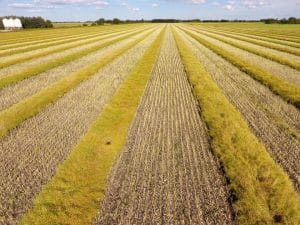One crop, many stages? Whether it’s due to a late spring rain that brought a second flush of plants, the disparity between moisture levels of slopes and low spots or other conditions that led to a less than uniform crop, it can be hard to decide when to swath a field of varying maturity.
- What to do: Try to focus on the ‘big picture’ and not on the small patches! Decide where the majority of the yield will be coming from and plan your crop staging and related field operations around that portion of the field. In some cases, the most mature areas could be due to disease, so don’t time the swathing operation around plants that will not contribute much to yield. For the less mature areas, aim to delay swathing until they have at least a degree of colour change, so long as it doesn’t greatly compromise the plants in the majority of the field. Read more.
Hot and dry and wanting to swath? If your canola has at least 60% seed colour change, and there are no translucent mushy seeds on the side branches, the repercussions of swathing in these conditions may be negligible or minor. Swathing a crop early is the worst thing one can do when conditions are particularly hot and dry.
- What to do: Either wait for the crop to mature more before cutting, or take advantage of a rain event, evening or morning temperatures and dew to swath. This will help to slow down that initial curing period, allowing for better seed fill and chlorophyll to clear from the seed. Read more
So excited to start that you are tempted to go in early? Don’t let the excitement of harvest or a potentially early-swathing neighbour throw off your plans to maximize your yield.
- What to do: Stick to your plan of waiting until your crop is close to or at 60% seed colour change and look forward to your increased yield reward for your patience. Seed colour change (SCC) is considered any amount of yellow or brown on the seed. (Read here for more tips.) There are lots of other things to do in the meantime, before you start swathing your canola. In addition to getting started on your other crops which may be closer to ideal swath or harvest timing, read the top 10 useful activities you can do before harvest.
Assessing a crop with lots of branching? Depending on your seeding rate, your row spacing, your emergence rate and the number of plants that surrendered to disease, insects or drought, you may have plants with a thicker stalk and a lot of branching. Branching doesn’t have to be a big concern if you know how to manage it.
- What to do: In any case, the ideal is to swath when most (or all) side-branch seeds are “firm to roll.” Mushy, watery seeds will not mature if swathed in that state. Read more on plant population and swath timing. Keep in mind that with lower plant populations, more yield will come from side branches. At 10 plants per square foot, about half the yield will come from main stem pods and half from branches. At 5 plants per square foot, two thirds of the yield comes from side branches. At 3 plants, three quarters of the yield comes from side branches.
Wanting to try out night swathing? You may have heard about other farmers specifically planning to swath their canola at night or after the dew comes down instead of during the day, but were wondering how effective it is and if it’s worth giving it a try.
- What to do: While it is better to swath under cool, moist conditions, and avoid hot, dry conditions, there are few published research results comparing swathing at night to during the day. However, avoiding the peak heat of the day (especially if occurring along with high winds) can minimize rapid drydown in the swath, resulting in small seeds that haven’t properly filled, or have locked in green seed. This may also help to reduce shattering to a degree. Either way, ensure you are accurately assessing seed colour change before starting to swath.
Eager to bin it? In some instances canola swathed at the recommended 60% seed colour change followed by hot and dry weather for several days, has resulted in some canola fields being ready to combine earlier than expected (in as little as five days, in some cases).
- What to do: Stalk material drydown can be the easiest way to visually assess swath harvest readiness. Once it appears dry, sample and assess whether moisture is around 10% or lower and green seed less than 2%. In certain conditions after swathing, this can happen faster than one might expect. More commonly, curing will occur over a period of 7-21 days, but it can happen in as little as three days.

